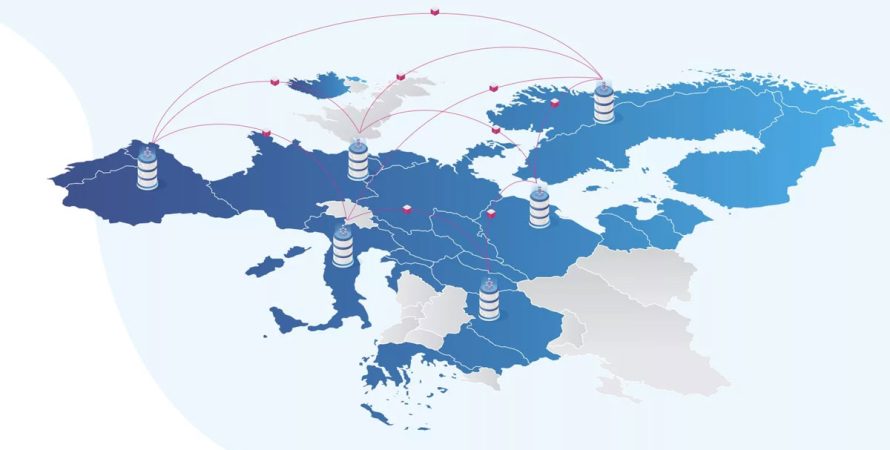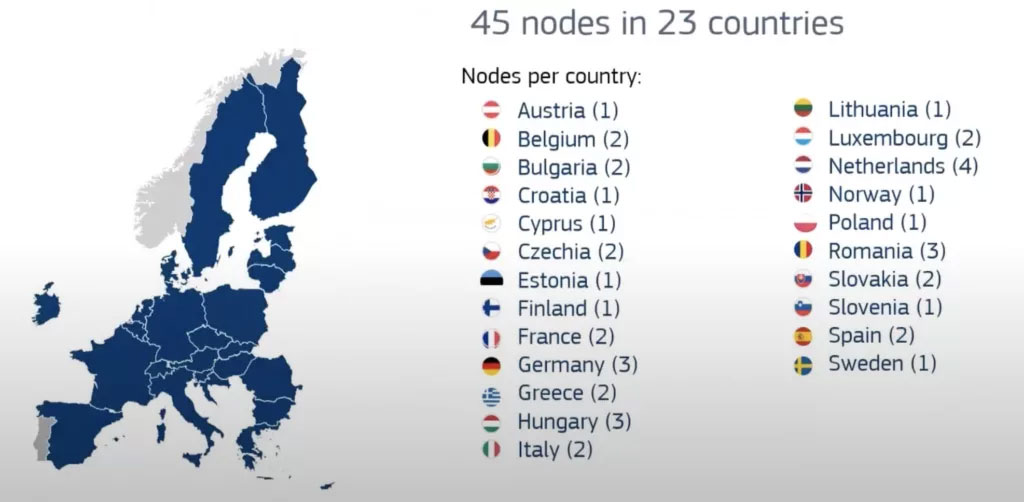EU Member States, Norway, Liechtenstein and the European Commission have launched a publicly accessible blockchain.
The regulated and permissioned blockchain is managed by the European Blockchain Services Infrastructure (EBSI).
It has 45 nodes in 23 countries as of last year according to Pierre Marro, an administrator at the European Commission (EC).
Germany has three nodes while France and Italy have two each with Netherlands having four nodes and pretty much all other EU countries have at least one.
As a new development, the initiative has particularly focused on university certificates, verifying them on the blockchain, but Belgium’s digital minister Mathieu Michel suggested that this project might soon be elevated in importance.
“EBSI is a project which exists right now, but that’s the beginning of something. There are some kinds of tiny applications trying to make some proof of concept.
Belgium will have the European presidency in 2024 and one of my goal during the presidency will be to transform the technical project EBSI into political projects,” Michel said.
The EU presidency rotates every six months through member states and whoever holds it can set the agenda. Slovenia for example held it recently and they particularly focused on EU’s expansion to candidate countries in the Balkans.
Belgium will clearly have a different focus with the minister stating “we need to build some kind of a political project about blockchain.”
The focus however will still remain on documents, with the minister stating:
“I could mention driving licenses or the way driving licenses could inter-operate between countries or identity cards, or passports, or the title of property…
The biggest value [in blockchain technology] for me is the data, the data which concerns yourself, the property title or driver’s license and so on.”
That makes this a bit more than just another blockchain project. It can be, first and foremost, a way to set up a continental level digital infrastructure, and if needed potentially in the future it can be a financial platform as well though the focus for now is on documentation.
The design is simple in a way at the technical level. It’s a Proof of Authority blockchain. You do need permission. We played with the idea of applying to run a node, but beyond the forms you need endorsement by European Blockchain Partnership representatives, ministers and the like of member states.
Stay in the know on crypto by frequently visiting Crypto News Today
As you can imagine that is probably a fairly lengthy process, but you can also participate by being a wallet provider. Here again you have to go through some screening of sorts to be a conformant wallet, as they call it.
Beyond that, it is not much different than a crypto wallet or blockchain. You replicate the data, you connect to one node to read or write to the blockchain as a wallet, and for any changes or upgrades to the blockchain, the nodes have to agree.
That makes this a centralized decentralized framework, especially as nodes are run by each member state. So they all have to agree if they want to change something outside the usual rules, and in theory there could be forks here too if member states break out into different blocks, or indeed a member state could break out to his own mini-blockchain, though he’d need to setup the whole permissions controls, which ultimately is some lines of code.
The code itself is open source as EBSI runs the Hyperledger Besu Ethereum Enterprise Client. This client can be used for the ethereum blockchain itself, for private networks, on Proof of Work, or Proof of Authority.
The public can access the blockchain through APIs – which to non-coders are like ips for communicating between computers or servers. While to coders these are very familiar:
curl --request POST \
--url https://api-pilot.ebsi.eu/ledger/v3/blockchains/besu \
--header 'Authorization: Bearer undefined' \
--header 'Content-Type: application/json' \
--data '{
"jsonrpc": "2.0",
"method": "eth_getBlockByNumber",
"params": [
"123456",
true
],
"id": 1
}'You could of course run your own node, but the coding part wouldn’t be much different. You’d just change the API key with your own node address and keep all the rest the same.
Which on the surface suggests that this project is proper at a technical level as they appear to be doing things largely right and to expected standards with it sounding fairly robust.
That illustrates just how much the skill level, outside of crypto proper, has developed in the past four years, as this is basically how a coder would expect a government level blockchain to operate.
Now this is about documents, ‘harmless things,’ but it could in theory be about the euro and euro based… we can’t call it crypto finance and digital finance wouldn’t be clear enough, so crypto-euro finance.
Such finance is a lot more complicated politically than permission controls for universities, but it would have some significant advantages in… well here again it wouldn’t be decentralized finance (defi), though they can potentially have the name open finance (ofi?) because it would be a lot more open than current banking.
Flashloans are one example of clear superiority in crypto, as are code based collateralizations where default is impossible, and thus risk is non existent beyond code exploits. Its 24/7 nature is another, instant transfers, or it being practically free to transact as the only reason cryptos are not is to keep the nodes small, which here wouldn’t quite apply, not least because they can easily do pruning.
A crypto-euro is a political matter however, but until now it was a technological matter as well in getting the design right.
Now, they have the tech so it’s just a matter of flicking the switch for the euro to become a crypto-euro, though obviously they would need to address the political aspects, including what here would be very political: permission controls, both internally in regards to the nodes and for the API.
For now though this is about documents, and there it can have a different role of creating a continental level digital framework that bridges borders to unify the system.
But it must be somewhat tempting as well to consider if an extension to finance, through a proper execution, would significantly advantage the continent as it would basically turn money into code, though with the old style permission controls.![]()
Read More at TRUSTNODES
Please Read Essential Disclaimer Information Here.
© 2024 Crypto Caster provides information. CryptoCaster.world does not provide investment advice. Do your research before taking a market position on the purchase of cryptocurrency and other asset classes. Past performance of any asset is not indicative of future results. All rights reserved.
Contribute to CryptoCaster℠ Via Metamask or favorite wallet. Send Coin/Token to Addresses Provided Below.
Thank you!
BTC – bc1qgdnd752esyl4jv6nhz3ypuzwa6wav9wuzaeg9g
ETH – 0x7D8D76E60bFF59c5295Aa1b39D651f6735D6413D
MATIC – 0x7D8D76E60bFF59c5295Aa1b39D651f6735D6413D
LITECOIN – ltc1qxsgp5fykl0007hnwgl93zr9vngwd2jxwlddvqt







